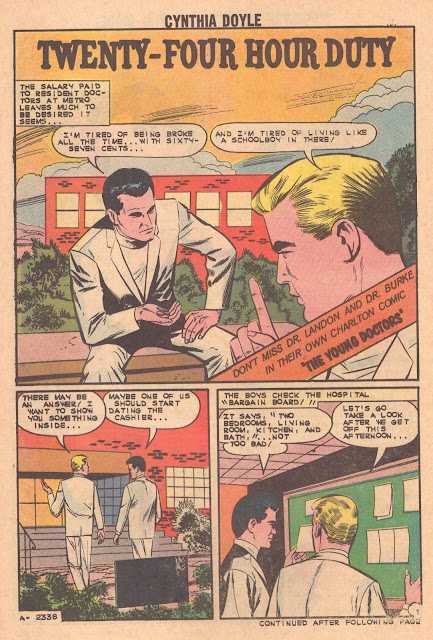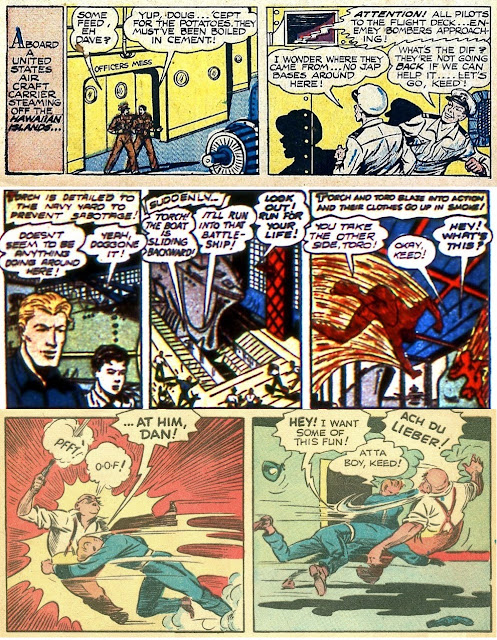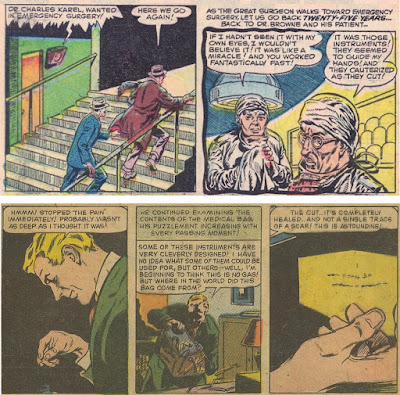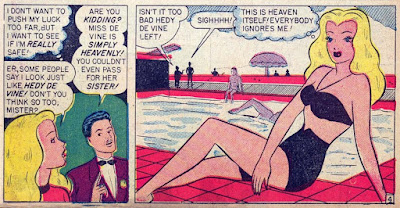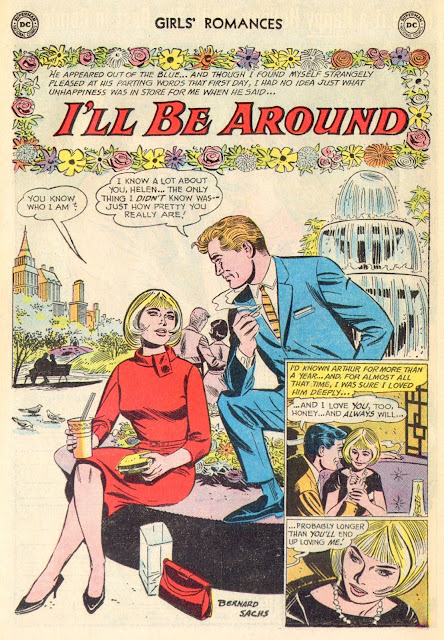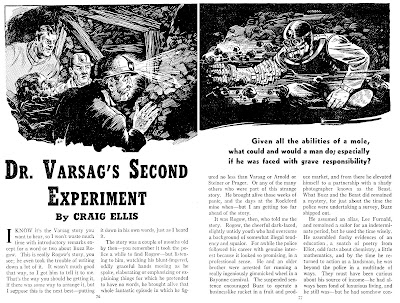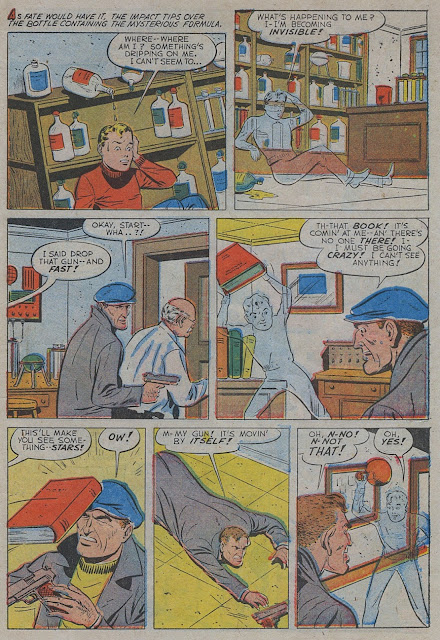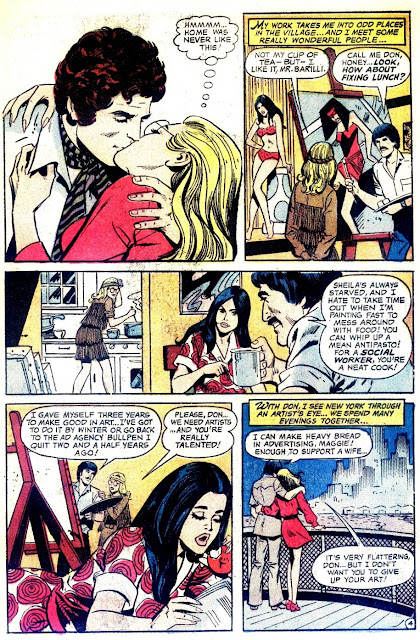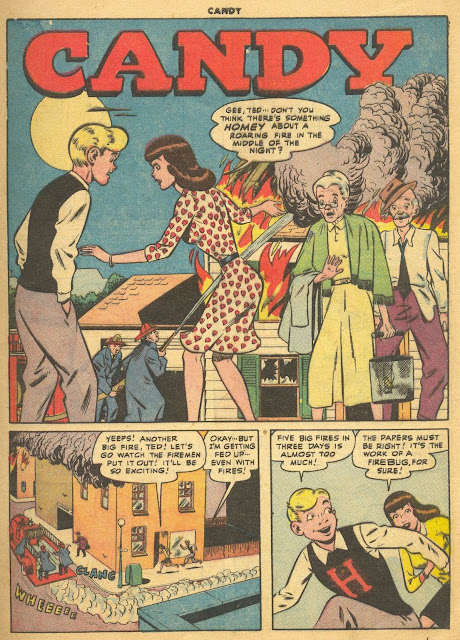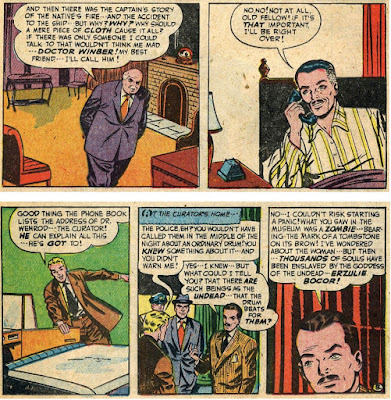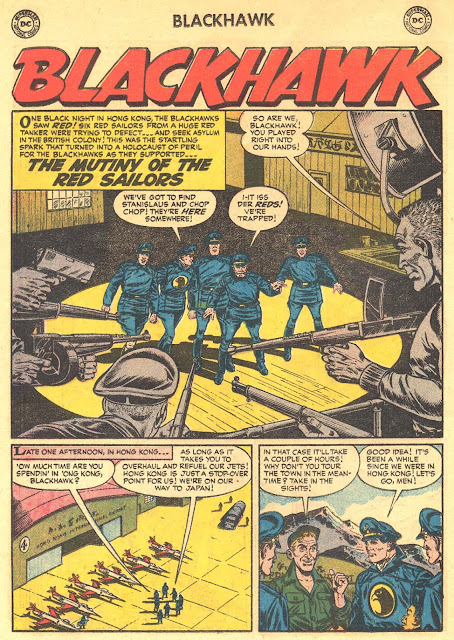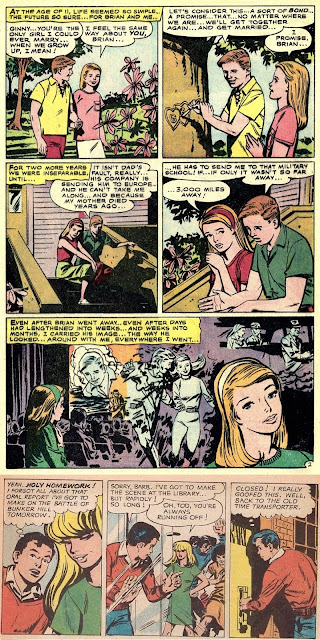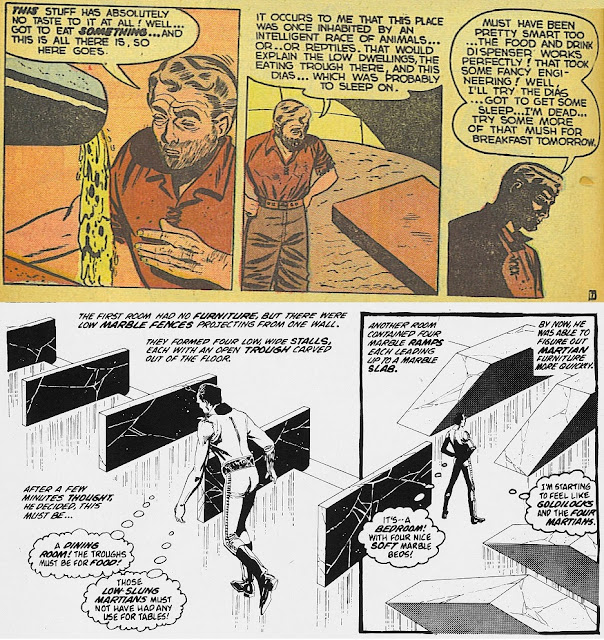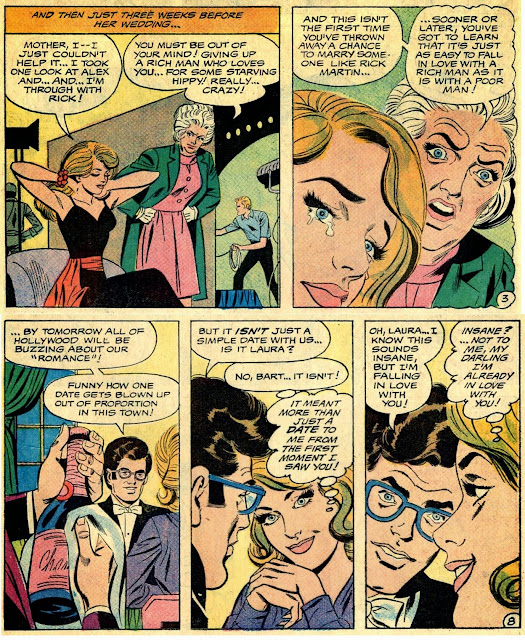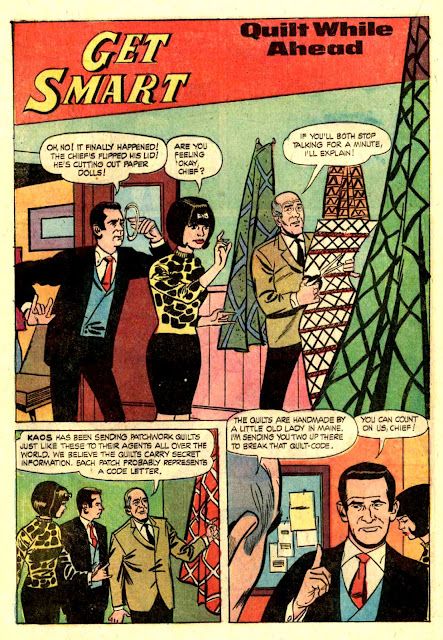Bob Oksner would have a 66-issue run on The
Adventures of Jerry Lewis from
61 (Nov-Dec/60)
to 126 (May-June/71) if it weren't broken up by Neal Adams' doing
101-104 in 1967—and this artist, whoever he may be, drawing issue 80 (Jan-Feb/64).
Any idea who this is?
Thursday, December 24, 2015
Sunday, December 13, 2015
Don Segall at Charlton--One Story Found
Back in antediluvian days, the only two credits superhero fans knew for
Don Segall were the Creeper origin in Showcase
73 (March-April/68) and
the story in Inferior Five
8 (May-June/68). If I'm recallling correctly, some time later in a
letter in one
of the fanzines—The
Comic Reader?—Mark
Evanier expanded upon Segall's writing career—mentioning his
working in television and, beyond DC in comics, for Dell and Charlton.
It's taken this long for me to stumble across a Charlton story by Don Segall: the Young Doctors back-up "Twenty-Four Hour Duty" in Cynthia Doyle, Nurse in Love 69 (Apr/63).
The use of "It seems" in the blurb is mirrored in the inside front cover one-pagers in Dell's Calvin and the Colonel 1 (Four-Color 1354, Apr-June/62) and 2 (July-Sept)—"It seems" in the first and "It looks like" in the second. "The boys" as in the final caption is something Segall uses likewise at Dell in, for instance, The Frogmen 7 (Nov-Jan/64).
The logical place to look for other Don Segall stories at Charlton would be in the Young Doctors' own title. I don't see such obvious clues to his writing there, but #1 and 2 are certainly not by Joe Gill, who takes over by #4 (I haven't seen #3).
Is Charlton trying to cash in on two particular doctor TV shows at once with the Young Doctors? I'd be shocked—shocked—to think so.
It's taken this long for me to stumble across a Charlton story by Don Segall: the Young Doctors back-up "Twenty-Four Hour Duty" in Cynthia Doyle, Nurse in Love 69 (Apr/63).
The use of "It seems" in the blurb is mirrored in the inside front cover one-pagers in Dell's Calvin and the Colonel 1 (Four-Color 1354, Apr-June/62) and 2 (July-Sept)—"It seems" in the first and "It looks like" in the second. "The boys" as in the final caption is something Segall uses likewise at Dell in, for instance, The Frogmen 7 (Nov-Jan/64).
The logical place to look for other Don Segall stories at Charlton would be in the Young Doctors' own title. I don't see such obvious clues to his writing there, but #1 and 2 are certainly not by Joe Gill, who takes over by #4 (I haven't seen #3).
Is Charlton trying to cash in on two particular doctor TV shows at once with the Young Doctors? I'd be shocked—shocked—to think so.
Friday, November 27, 2015
Riss on Gayle and Gayle
The
Who's Who
credits Pete Riss with Toni Gayle, the fashion
model/amateur sleuth, at Premium. Since there are different
indexers on different issues in the Grand Comics Database,
some of Riss's Toni Gayle stories are IDed (those in Young
King Cole and the fifth issue of
Guns against Gangsters)
and some
aren't. The indexer
who does ID those stories, citing the Who's
Who for Riss, posits Janice
Valleau as inker (I have no
useful opinion there).
The Who's Who neglects to credit Riss for the spin-off strip, The Gunmaster—Gregory Gayle (Toni's police detective father). For each of Riss's Gunmaster stories in Guns against Gangsters, there's a Toni Gayle story by him in the same issue for comparison.
Pete
Riss pencils
on THE GUNMASTER—GREGORY GAYLE
in Guns against Gangsters
on TONI GAYLE
in Young King Cole
in Guns against Gangsters
in 4Most
The Who's Who neglects to credit Riss for the spin-off strip, The Gunmaster—Gregory Gayle (Toni's police detective father). For each of Riss's Gunmaster stories in Guns against Gangsters, there's a Toni Gayle story by him in the same issue for comparison.
on THE GUNMASTER—GREGORY GAYLE
in Guns against Gangsters
| Sept-Oct/48 | v1 #1 | The Green-Suit Murders |
| Nov-Dec/ | v1 #2 | The Sugar Bowl Murder |
| Jan-Feb/49 | v1 #3 | The Mystery of the Million-Dollar Carbine |
on TONI GAYLE
in Young King Cole
| May/48 | v3 #10 | She Scores Quite a Hit |
| June/ | v3 #11 | Mighty Thunder Falls |
| July/ | v3 #12 | Redstone Park |
in Guns against Gangsters
| Sept-Oct/48 | v1 #1 | Case of the Sacred Cobra |
| Nov-Dec/ | v1 #2 | The Case of the Fortunate Fiddle |
| Jan-Feb/49 | v1 #3 | The Case of the Fat Thin Man |
| Mar-Apr/ | v1 #4 | The Case of the Parisian Strangler |
| May-June/ | v1 #5 | She Gets in Dutch |
in 4Most
| Jan-Feb/49 | v8 #1 | More Than One Way to Win a Football Game |
Monday, November 16, 2015
A Couple of Mickey Spillane's Comics Stories at Timely
Mickey Spillane had plenty of text pages at Timely, but not a single
credited comics story. He was one of the group of writers working for
Funnies, Inc. supplying strips to a number of publishers, Timely and
Novelty being the two getting the longest spans of issues from the
shop, I believe.
I hadn't seen a Novelty book until I started looking into the Funnies, Inc. output a few weeks ago, and was pleased to find a number of stories credited to the writers as well as artists on the splash pages. The bottom tier here is from Spillane's Cadet story "Espionage! In the Senate Building!" in Target Vol. 3 #7 (Sept/42).
The other writers whose stories I've begun to find more of include Ray
Gill, Kermit Jaediker, Roy Garn, and George Kapitan. The most noted, of
course, is future novelist Spillane. So far I've found all of
two stories I'd attribute to him at Timely.
He's known to have worked on the short-lived WWII-centric strip Jap-Buster Johnson, and in fact this story is the origin, "Friendship" from U.S.A. Comics 6 (Dec/42). The Spillaneism I've excerpted in all three tiers is "keed" for "kid"; the "yup" seen here is another one he uses. "Aghrr", seen later in the story, in various hyphenizations is used by a number of the Funnies, Inc. writers, although this is the one time I've seen Spillane use it. It's in the next story in #7, but among other things, Johnson's first name has changed from Doug to Everett, so I don't jump at Spillane for that one.
His one Timely superhero story that I've come across so far is "The Case of the Attempted Dreadnaught Disasters" in Human Torch 7 (Spring/42). A Spillaneism seen later in the story is "Ye gods." This is the point at which Carl Burgos had just stopped writing all the Torch stories he was drawing.
I hope eventually this will lead to Mickey Spillane’s stories elsewhere—for Captain Marvel and such.
I hadn't seen a Novelty book until I started looking into the Funnies, Inc. output a few weeks ago, and was pleased to find a number of stories credited to the writers as well as artists on the splash pages. The bottom tier here is from Spillane's Cadet story "Espionage! In the Senate Building!" in Target Vol. 3 #7 (Sept/42).
He's known to have worked on the short-lived WWII-centric strip Jap-Buster Johnson, and in fact this story is the origin, "Friendship" from U.S.A. Comics 6 (Dec/42). The Spillaneism I've excerpted in all three tiers is "keed" for "kid"; the "yup" seen here is another one he uses. "Aghrr", seen later in the story, in various hyphenizations is used by a number of the Funnies, Inc. writers, although this is the one time I've seen Spillane use it. It's in the next story in #7, but among other things, Johnson's first name has changed from Doug to Everett, so I don't jump at Spillane for that one.
His one Timely superhero story that I've come across so far is "The Case of the Attempted Dreadnaught Disasters" in Human Torch 7 (Spring/42). A Spillaneism seen later in the story is "Ye gods." This is the point at which Carl Burgos had just stopped writing all the Torch stories he was drawing.
I hope eventually this will lead to Mickey Spillane’s stories elsewhere—for Captain Marvel and such.
Tuesday, November 3, 2015
Swipe from the Best
"If you're going to swipe, don't be shy about it" seems to be the guiding principal here. Don't use something hidden away in the back pages of some years-ago comic!
The original, the cover of DC's Boy Commandos 1 (Win/42-43) is penciled by Jack Kirby. The swipe, from the story "North Africa—Ahoy!" in Timely's Young Allies 8 (July/43) is in an issue both of whose two feature stories are attributed in the Grand Comics Database to three pencillers (not to mention two inkers), so who knows who did this particular panel?
The moral here might be "At least pay attention to what you're swiping." In moving around and restructuring Kirby's figures, the artist has put Brooklyn's foot on the end of the Rip Carter replacement's leg.
On the subject of swiping from DC, by the way, does anyone know of any specific examples of Superman-to-Captain Marvel swipes in the Forties? Supposedly there were scrapbooks full of them meant to convince a judge that Fawcett might as well have been sending operatives into the DC offices at night with microfilm cameras. In my far more casual perusal I have yet to stumble across any.
The original, the cover of DC's Boy Commandos 1 (Win/42-43) is penciled by Jack Kirby. The swipe, from the story "North Africa—Ahoy!" in Timely's Young Allies 8 (July/43) is in an issue both of whose two feature stories are attributed in the Grand Comics Database to three pencillers (not to mention two inkers), so who knows who did this particular panel?
The moral here might be "At least pay attention to what you're swiping." In moving around and restructuring Kirby's figures, the artist has put Brooklyn's foot on the end of the Rip Carter replacement's leg.
On the subject of swiping from DC, by the way, does anyone know of any specific examples of Superman-to-Captain Marvel swipes in the Forties? Supposedly there were scrapbooks full of them meant to convince a judge that Fawcett might as well have been sending operatives into the DC offices at night with microfilm cameras. In my far more casual perusal I have yet to stumble across any.
Friday, October 23, 2015
One Springboard for Two Stories
As EC's publisher, Bill Gaines would read at home as much as he could
to bring in "springboards" to story conferences with editor Al
Feldstein. Generally they would take ideas, including some from
Gaines's reading, to come up with plots and build new new
stories around them. Famously, Ray Bradbury differed with them on the
definition of "new" when they hewed too closely to a couple of his
stories.
If comic book writers do any reading at all, of course others' ideas may resurface even unconsciously as springboards for scripts. Where is the line crossed into plagiarism?
C. M Kornbluth's story "The Little Black Bag" was published in Astounding Stories, July/50. The situation involves a doctor finding a bag of surgical instruments from the future. I've recognized that situation in two comic book stories that came out a few years later.
"Little Black Bag" is from Marvel
Tales 134 (May/55); artist
Robert Q. Sale, and writer unknown. "The Strange Package" is from
Strange Suspense Stories
36 (March/58); art by (of all people, at Charlton) Gene Colan and
script by Joe Gill. [CORRECTED FROM SSS 33 PER PAUL BRIGG'S COMMENT]
Neither follows the Kornbluth story's plot at all closely; that had a grisly ECish ending, and these two stories came out under the Comcs Code. Still, (especially considering the Marvel story's title), it's obvious the writers were familiar with the prose story. I wonder if Edmond Hamilton springboarded it even further into "The Burglar Kit from the Future" in Jimmy Olsen...
As to Joe Gill's style, in "The Strange Package" there's a good example of his joining two sentences with an "and" but no comma in a caption: The hospital was close and he walked through the early, gathering darkness toward it!
If comic book writers do any reading at all, of course others' ideas may resurface even unconsciously as springboards for scripts. Where is the line crossed into plagiarism?
C. M Kornbluth's story "The Little Black Bag" was published in Astounding Stories, July/50. The situation involves a doctor finding a bag of surgical instruments from the future. I've recognized that situation in two comic book stories that came out a few years later.
Neither follows the Kornbluth story's plot at all closely; that had a grisly ECish ending, and these two stories came out under the Comcs Code. Still, (especially considering the Marvel story's title), it's obvious the writers were familiar with the prose story. I wonder if Edmond Hamilton springboarded it even further into "The Burglar Kit from the Future" in Jimmy Olsen...
As to Joe Gill's style, in "The Strange Package" there's a good example of his joining two sentences with an "and" but no comma in a caption: The hospital was close and he walked through the early, gathering darkness toward it!
Tuesday, October 13, 2015
Binder Records: Timely--Link to Art Lortie's Transcription
Art Lortie has transcribed Otto Binder's pay records, separating them by company. The first list he's posted is Binder's work for Timely, which covered 1941-48. Like William Woolfolk, Binder gave his scripts working titles that in many instances the editors changed. A few times the working title gives away the ending, so you can see the editors' point. At any rate, a number of stories in the records still have to be connected to the ones published.
This is the link:
http://thebookstork.wikispaces.com/Otto+Binder%27s+Pay+Records+Part+1+-+Marvel
Comparing Binder's records with Woolfolk's from the same era, it would seem that at Timely each was paid for quite a few more scripts than ended up drawn and published (I'm pretty certain it will prove so with Binder once all the published stories have been IDed). It happened most notably to both men on Captain America and Young Allies.
One difference between the two writers' work at Timely is that as it became apparent that the superheroes were destined to fade away for a while, Binder switched over to the teen titles there. This tier is from the Hedy de Vine story "Disguise the Limit" in Millie the Model 15 (Dec/48). I never looked for Binder's work among these stories, but knowing now that he was paid for this one (his title was "Incognito"), I can see the characteristic elongation of "Sighhhh."
This is the link:
http://thebookstork.wikispaces.com/Otto+Binder%27s+Pay+Records+Part+1+-+Marvel
Comparing Binder's records with Woolfolk's from the same era, it would seem that at Timely each was paid for quite a few more scripts than ended up drawn and published (I'm pretty certain it will prove so with Binder once all the published stories have been IDed). It happened most notably to both men on Captain America and Young Allies.
Saturday, October 3, 2015
Girls' Romances 101-120 Artists
This is Jack Miller's first run on Girls'
Romances;
he returns after Barbara Friedlander edits the title. I picked this run
because much of John
Rosenberger's work at this point on DC's romance books gets mistaken
for Gene Colan's, and Frank Bolle gets no recognition at all.
Nor do Colan and J. Scott Pike get any love for inking
themselves. I haven't seen issues
105 and 110. I've left out the reprints that come in toward the end of
the
run. And I've put aside the question of writers for now.
Bernard Sachs signs one story here on his own (he does the same on a
story in Girls' Love Stories
111 and one in Young Romance
133, also 1965 issues). I'm going to take
the signature at face value. His pencils, then, certainly remind you of
an earlier Mike Sekowsky's, but in the latter's stories inked by others
at this time Sekowsky's style has already become more exuberant.
There's one inker I can track from story to story for whom my best guess is Frank McLaughlin, although he's not known to be at DC this early. And if Art Peddy has any work here, I just can't ID him this late.
In "Too Handsome to Hold" in #104, where a young man happens to look just like actor Richard Chamberlain, I believe Tony Abruzzo rather than penciller Mike Sekowsky draws most of the Chamberlain faces.
Girls' Romances edited by Jack Miller
There's one inker I can track from story to story for whom my best guess is Frank McLaughlin, although he's not known to be at DC this early. And if Art Peddy has any work here, I just can't ID him this late.
In "Too Handsome to Hold" in #104, where a young man happens to look just like actor Richard Chamberlain, I believe Tony Abruzzo rather than penciller Mike Sekowsky draws most of the Chamberlain faces.
Girls' Romances edited by Jack Miller
| Jun/64 | 101 | Tears for Sale | a: John Rosenberger |
| Dreamers Love Their Dreams | a: Rosenberger | ||
| Dear Peter... | a: Frank Bolle | ||
| Come Back My Heart | a: J. Scott Pike | ||
| Jul/ | 102 | Something in Common | p: Mike Sekowsky i: Frank Giacoia? & Joe Giella? |
| Out of a Dream | a: Bolle | ||
| The Day My Heart Died | p: Tony Abruzzo i: Giacoia | ||
| Sep/ | 103 | Port of Hope | a: Bolle |
| Let's Fall in Love | a: Bernard Sachs | ||
| Too Late for Tears | a: Gene Colan | ||
| Oct/ | 104 | A Change of Heart | a: Sachs |
| Tell Him Tonight | p: Abruzzo i: Frank McLaughlin | ||
| Too Handsome to Hold | p: Sekowsky i: ? | ||
| Jan/65 | 106 | Stand-In for Love | a: Bolle |
| I'll Be Around | a: Sachs (signed) | ||
| I'll Never Love Again | a: Rosenberger | ||
| Mar/ | 107 | Come Back to Yesterday | p: Werner Roth i: McLaughlin |
| The Love I Lost--Twice | a: Gil Kane | ||
| Alone in Love | a: Rosenberger | ||
| Apr/ | 108 | I Was the Last to Know | p: ? i: Sachs |
| Come Home to Heartbreak | p: Abruzzo? i: McLaughlin | ||
| Take My Love | a: Colan | ||
| Jun/ | 109 | Why Would Anyone Love Me? | a: Sachs |
| A Bedtime Story | a: Bill Draut | ||
| When My Dreams Come True | a: Colan | ||
| Sep/ | 111 | How to Lose Your Boyfriend without Really Trying | a: Rosenberger |
| He Only Loves Me--When He's Kissing Me | a: Colan | ||
| Oct/ | 112 | Too Much in Love? | p: Roth i: Bolle |
| All for the Love of Ronny | p: Abruzzo i: McLaughlin | ||
| Give Me Back My Love | a: Rosenberger | ||
| Dec/ | 113 | If I Ever Love Again--(I'll Keep a Lock on My Heart) | a: Rosenberger |
| I'll Love You Forever | p: John Romita i: ? | ||
| Careless Heart--Careless Lips | a: Pike | ||
| Jan/66 | 114 | Phantom Love | a: Colan |
| Heartbreak Follows Me | p: Abruzzo i: Sachs | ||
| Kiss and Tell | a: Romita | ||
| Mar/ | 115 | Please, Somebody--Love Me | a: Rosenberger |
| Love at Second Sight | a: Win Mortimer | ||
| Apr/ | 116 | How Can He Love Me Now | a: Pike |
| My Divided Heart | p: ? i: Sachs | ||
| June/ | 117 | Girl in Trouble | a: Colan |
| The Wrong Side of Love | a: Rosenberger | ||
| July/ | 118 | He Couldn't Trust Me | a: Rosenberger |
| Say Goodbye to Love | a: Colan | ||
| Sep/ | 119 | Love Wasn't Enough for Him | a: Colan |
| One Ticket--to Romance | a: Sachs | ||
| Ask Me about Love--I'm an Expert | p: Dick Giordano i: Sal Trapani | ||
| Oct/ | 120 | Can You Tell Someone to Love You? | a: Manny Stallman |
| Maybe He'll Love Me Tomorrow | a: Rosenberger |
Thursday, September 24, 2015
Dr. Varsag's Experiment 2.1
Both Varsag pulp stories were credited to Craig Ellis, but that pen name covered a different writer on each one (see the ISFDB; I found the info in the 1952 Day Index.). The first is the only SF story that Lee Rogow had published, as far as I know. The second is by David V. Reed. He used the pen name Coram Nobis for his Plop! scripts like the "Dr. Varsag" refry. (The artist is Lee Marrs.)
The first Varsag experiment in Amazing involved giving someone superspeed with mongoose-based injections. Does that sound as if some comics writer lifted it a lot sooner than 1975?
Friday, September 18, 2015
A 70s Marvel Artist's First Stories at Timely (UPDATE: Well, One of Them)
Among the artists are some just starting out, who haven't developed the styles we recognize from the Marvel Age. Dr. Michael J. Vassallo has tracked Gene Colan's Timely work, for instance, to the artist's first stories, by working backwards month by month from his earliest signed work later in the Fifties—Colan's style is just the tiniest bit different a month before, and just a tiny bit more different the month before that, until at last it would be just about unrecognizable around 1948 if one didn't follow it step by step through the increments of change.
But Don Perlin's style seems to have sprung forth fully grown, as if from the brow of Zeus. This page is from "He Dreamt of Doom." So far I've looked at only the first two years of the crime books; they're something of a chore to go through before the scripts and arts become more appealing.
The Grand Comics Database has Perlin doing two one-page pieces in Western Winners 6 (Aug/49), but there I must confess I can't see him. When most of the artists start signing their work, Perlin does too; for instance, he has a story in Marvel Tales 110 (Dec/52) signed with inker Abe Simons.
UPDATE: Per Doc V.'s comment, I've dropped the other two stories ("Her Night of Peril" in Lawbreakers Always Lose 8 and "The Witch's Son" in Marvel Tales 96) that I'd listed here originally. I let myself see something Perlinesque in one or two panels in those, but I think "He Dreamt of Doom" shows Perlin in every panel.
early Don Perlin at Timely:
All True Crime Cases
| Sept/49 | 35 | He Dreamt of Doom |
Wednesday, September 9, 2015
Star Spangled War Writers Before Kanigher
Star
Spangled War Stories
was the one DC war comic not edited by Robert Kanigher at the start, so
there are no records extant for its first issues' writers and artists.
Reportedly it was Murray Boltinoff, solo, behind the
indicia's editing credit to Whitney
Ellsworth.
This page from "The Sad Sack Squad" in #9 provides four or five clues to Jack Miller. In some other SSWS stories he uses a sound effect he doesn't need that much in mystery or superhero scripts: Peeow for the sound of a shell. As usual, there are other stories in this run that I'm only half-convinced could be Miller's or Herron's; maybe on another pass I'll be better sure of some and add to the list.
Kanigher takes over editing with issue 13. The one story whose writer is not on his records, "Gen. Hunger" in #19, evidently is inventory from Boltinoff. The art is by Howard Sherman, who had a couple of stories in the earliest issues of SSWS but none that I can think of otherwise in the Kanigher books.
Early Star Spangled War Stories writers
This page from "The Sad Sack Squad" in #9 provides four or five clues to Jack Miller. In some other SSWS stories he uses a sound effect he doesn't need that much in mystery or superhero scripts: Peeow for the sound of a shell. As usual, there are other stories in this run that I'm only half-convinced could be Miller's or Herron's; maybe on another pass I'll be better sure of some and add to the list.
Kanigher takes over editing with issue 13. The one story whose writer is not on his records, "Gen. Hunger" in #19, evidently is inventory from Boltinoff. The art is by Howard Sherman, who had a couple of stories in the earliest issues of SSWS but none that I can think of otherwise in the Kanigher books.
Early Star Spangled War Stories writers
| Nov/52 | #3 | "Hundred-Mission" Mitchell | Jack Miller |
| Booby-Trap | Ed Herron | ||
| Dec/ | #4 | Buy Your Way Out | Herron |
| Jan/53 | #5 | Take Hill 21--Or Else! | Herron |
| Combat Cowboy | Miller | ||
| Feb/ | #6 | Operation Davy Jones | Herron |
| Mar/ | #7 | The Rookie Ranger | Miller |
| Apr/ | #8 | I Was a Hollywood Soldier | Miller |
| May/ | #9 | The Sad Sack Squad | Miller |
| Diary of a Dogface | Miller | ||
| Double Trouble | Miller | ||
| Jun/ | #10 | The G.I. and the Gambler | Miller |
| The Last Bullet | Miller | ||
| Jul/ | #11 | The Flag and the Fort | Miller |
| The Fighting Hick | Miller | ||
| The Girl They Left Behind | Miller | ||
| Mar/54 | #19 | Gen. Hunger | Miller |
Tuesday, September 1, 2015
The Dinosaur Island Artist on Sub-Mariner
The "Dinosaur Island" artist (1946-48 at DC), Paul Cooper, works
on Sub-Mariner at Timely before moving over to Batman. He has
more than one inker here (possibly one of them is himself—who
knows?). The figure poses are the better way to find Cooper's pencils
when close-ups of faces show more of the inker's style.
There are a few other stories from this period that I've spent days considering and finally decided to leave off the list, and it's the inking that's made it hard to tell.
For what it's worth, in every story below, the final panel closes as you see in "Horror Island"—with "End", rather than "The End" as in the other features in these issues.
Paul Cooper pencils on Sub-Mariner
in Marvel Mystery Comics
in Human Torch
in All Winners
in All Select
There are a few other stories from this period that I've spent days considering and finally decided to leave off the list, and it's the inking that's made it hard to tell.
For what it's worth, in every story below, the final panel closes as you see in "Horror Island"—with "End", rather than "The End" as in the other features in these issues.
Paul Cooper pencils on Sub-Mariner
in Marvel Mystery Comics
| Sep/45 | 66 | Sub-Mariner vs. the Murderous "Zako" |
| Nov/ | 67 | The Lost Soldier |
in Human Torch
| Fall/45 | 20 | The Carnival Murders |
| Win/46 | 21 | Murder in Blackout |
in All Winners
| Sum/45 | 16 | The Fabulous Racket |
in All Select
| Sum/46 | 10 | Horror Island |
Saturday, August 22, 2015
The Final Siegel & Shuster Story
ME's Funnyman in 1948 was bylined Jerry Siegel and Joe Shuster; I
myself can't see any Shuster work there. If he did, for instance, any
layouts, they're overwhelmed by finishes that look like full art by the
likes of John Sikela.
The GCD inexplicably attributes "You Can't Escape" in Atlas's Adventures into Terror 6 (Oct/51) to Joe Shuster when it isn't by him. His signed work at Charlton in the mid-Fifties is ghosted by Bill Molno. Attributions to Shuster on crime at St. John in the same time period are back-formations from the Charlton work; those St. John stories are drawn by Molno.
Shuster did have work at St. John, though. Their Approved Comics reprinted Ziff-Davis features, but issue 2 (March/54), Invisible Boy, is evidently inventory. The Who's Who puts Jerry Siegel's Invisible Boy scripting at Z-D, where he was an editor, and attributes the feature at St. John to Paul S. Newman. As far as I can tell, the scripter on the book is indeed Siegel.
I have no idea who drew the issue's three other stories, although the style feels familiar. But the art on the first one, "The Secret Formula," is by Joe Shuster; his style hasn't morphed into something dramatically different from the early Superboy stories. This, not those Charlton stories, would be his final work in comic books, and unlike the Superboy feature, teamed him one last time with Jerry Siegel.
The GCD inexplicably attributes "You Can't Escape" in Atlas's Adventures into Terror 6 (Oct/51) to Joe Shuster when it isn't by him. His signed work at Charlton in the mid-Fifties is ghosted by Bill Molno. Attributions to Shuster on crime at St. John in the same time period are back-formations from the Charlton work; those St. John stories are drawn by Molno.
Shuster did have work at St. John, though. Their Approved Comics reprinted Ziff-Davis features, but issue 2 (March/54), Invisible Boy, is evidently inventory. The Who's Who puts Jerry Siegel's Invisible Boy scripting at Z-D, where he was an editor, and attributes the feature at St. John to Paul S. Newman. As far as I can tell, the scripter on the book is indeed Siegel.
I have no idea who drew the issue's three other stories, although the style feels familiar. But the art on the first one, "The Secret Formula," is by Joe Shuster; his style hasn't morphed into something dramatically different from the early Superboy stories. This, not those Charlton stories, would be his final work in comic books, and unlike the Superboy feature, teamed him one last time with Jerry Siegel.
Thursday, August 13, 2015
Schaffenberger Romance at DC
I'm surprised Kurt Schaffenberger didn't do much more romance at DC than these stories (there are issues I haven't seen yet, so maybe there are a few). He does have a credited story later, in Young Love 124 (Mar/77).
Evidently others aren't expecting him there either, because his pencils on these two stories have gone unidentified. Nobody's made a guess on "Look before You Love;" and "Where the Action Is" (as seen above) has been attributed to Jay Scott Pike on pencils. Up to a point you can say "Vince Colletta" to explain it, but there's plenty of credited Schaffenberger/Colletta art on the superhero books in the Seventies for comparison; also for comparison, the story before "Where the Action Is" in GLS 178, "Play with Fire," is indeed (as attributed) Pike/Colletta.
Kurt Schaffenberger pencils on DC romance:
Falling in Love
| Oct/72 | 137 | Look before You Love | w: Jack Oleck i: Vince Colletta |
Girl's Love Stories
| Jul-Aug/73 | 178 | Where the Action Is | i: Colletta |
Wednesday, August 5, 2015
Pete Riss Candy
I'd say the feature's main artist, Harry Sahle, is inking at least the faces of Candy and her boyfriend Ted on these stories. On the archery story in #10 and the love in the stars one in #11 it looks more as if he's doing full inks over Riss pencils, but one or two minor characters like a soda jerk are distinctively Riss's, and in a few long shots Candy's arms look like hinged sticks. Sahle signs many of his solo stories, but he signs none of these—they're not being ghosted per se.
There are other stories in this run that strike me as not penciled by Sahle (one between these two in #11, for instance), but I have no idea who the pencillers other than Riss might be.
Pete Riss
Candy Pencils
| Autumn/47 | 1 | [The Firebug] "Gee, Ted..." |
| [The Book Shop] "Isn't it wonderful..." | ||
| Feb/49 | 8 | [Babysitting Caspar] "I'm glad..." |
| June/ | 10 | [Archery] "Tina, why..." |
| Aug/ | 11 | [Phineas Burnham, the Circus Man] "Candy! That tiger..." |
| [True Love in the Stars] "They say..." | ||
| Oct/ | 12 | [Buying Herman a Car] "Candy, when I..." |
Thursday, July 30, 2015
Wait Fifteen Years for Johnny Craig
At one point I thought I saw some Jack Kirby pencils at ACG when he
never
actually had anything published there. Seeing Johnny Craig
pencils there in a 1949 story might make more sense, since he certainly
worked
for them a decade and a half later. The story in question (see
the first tier excerpted) is
"The Mummy's Cloth" in Adventures
into the Unknown 7 (Oct-Nov/49),
attributed
in the Grand Comics Database to Craig with inks by Harry Lazarus.
Actually the penciller (if not full artist) is Pete Riss.
Riss has a number of stories correctly attributed at ACG in this period—the first story in Romantic Adventures 1 (Mar-Apr/49) for one, but more to the point, ones in AITU 4, 8, 10, and 11 in 1949-50.
Oh, and one more (from which I take my example's second tier): the next comics story in AITU 7, "Drums of the Undead."
Riss has a number of stories correctly attributed at ACG in this period—the first story in Romantic Adventures 1 (Mar-Apr/49) for one, but more to the point, ones in AITU 4, 8, 10, and 11 in 1949-50.
Oh, and one more (from which I take my example's second tier): the next comics story in AITU 7, "Drums of the Undead."
Thursday, July 23, 2015
Double Date with Millie
Stan recycles Millie titles even more frequently than storylines; "A Peach at the Beach" turns up on three stories besides the one listed below. "Bedlam at the Beach" he uses twice within two issues: Life with Millie 12 and 13. "Beauty at the Beach" he uses twice within one issue: for a one-page gag and then a full story in Millie the Model 105.
A Date with Millie, the companion title to Millie the Model, changes its title to Life with Millie with #8.
Stories in A Date with Millie
reworking earlier scripts
| Dec/59 | 2 | [taking up a collection gag] |
| from MILLIE 29 2nd 1-page gag | ||
| [art museum gag] | ||
| from MILLIE 32 3rd 1-page gag | ||
| [the man in the tuxedo] | ||
| from MILLIE 29 The Scheme | ||
| Jun/60 | 5 | "The Burpi-Cola Beauts" |
| from MILLIE 29 "Meet Miss Burpi-Cola" | ||
| Aug/ | 6 | "A Peach at the Beach" |
| from MILLIE 32 1st story | ||
| "Millie's Merry Pin-Up" [soda gag] | ||
| from MILLIE 21 cover | ||
| "What Makes Millie Mad?" | ||
| from MILLIE 92 cover for splash | ||
| and MILLIE 32 5th 1-page gag for story | ||
| Oct/ | 7 | "And That's No Bull" |
| from MILLIE 39 Chili story | ||
| "Millie's Secret Admirer" | ||
| from MILLIE 42 2nd Millie story |
in Life with Millie
| Dec/ | 8 | "The Restless Rassler" |
| from MILLIE 39 2nd Millie story | ||
| "Chili Dates a Star" | ||
| from MILLIE 32 Chili story |
Thursday, July 16, 2015
A Quality Writer Comes to DC
The writers already at DC assigned to the feature at this point include Jack Miller and Dave Wood; possibly Dick Wood too, who had worked on it into 1955 at Quality. I'm still working out the authorship of the individual non-Bernstein stories.
It would seem that the only completed story art done at Quality that DC received in the deal is "The Mutiny of the Red Sailors" in 108; the letterer is whoever worked on the title as of 107. "The Threat from the Abyss" may have been passed along to DC as a script; it too is an anti-Communist story of the sort that DC didn't much do on their own (and it's the final story in which the Blackhawk song appears at the end). My opinion is that Bernstein wrote most of the stories here directly for DC; he's moved to Aquaman, Green Arrow, and Congo Bill by the end of 1957.
Robert Bernstein
Blackhawk Scripts at DC
| Jan/57 | 108 | The Threat from the Abyss |
| The Mutiny of the Red Sailors | ||
| Feb/ | 109 | The Avalanche King |
| Blackhawk the Sorcerer | ||
| Mar/ | 110 | The Mystery of Tigress Island |
| Apr/ | 111 | The Perils of Blackie, the Wonder Bird |
| Trigger Craig's Magic Carpet | ||
| Aug/ | 115 | The Tyrant's Return |
| Blackie Goes Wild |
Thursday, July 9, 2015
Carl Pfeufer's DC Romance
One artist on a couple of romance stories at DC I felt I should
be able to put a name to. It wasn't until I checked the Who's
Who that
the coin dropped and I got the name: Carl Pfeufer. I had seen some of
his
Sixties
work on a few backups in the Harvey Thrillers—and on Super
Green Beret at Lightning Comics. The tier
below the "Two Hearts on a Tree" page is from Super
Green Beret 2 (June/67).
The Who's Who
has Pfeufer down for Secret
Hearts but not for Falling
in
Love. It also credits him with
work in Girl's Love Stories
(likewise
in
1967), but I haven't run across any of his stories there yet.
Carl Pfeufer at DC:
Falling in Love
Secret Hearts
Carl Pfeufer at DC:
Falling in Love
| Jan/67 | 88 | Leave My Heart Alone |
Secret Hearts
| July/67 | 121 | Two Hearts on a Tree |
Wednesday, July 1, 2015
Space Adventures--Carl Memling and More
Below are
listed the stories in Charlton's Space
Adventures that I
attribute to Carl Memling from the writing style. While
looking over
the run, I came across some
other items of interest.
"The Uncharted Planet" in #6 (May/53) is lifted from A. E. Van Vogt's story "Enchanted Village" in the magazine Other Worlds (July/50). It had already been lifted in Atlas/Marvel's Journey into Unknown Worlds 9 (Feb/52) as "The Four Walls" and would be legitimately adapted in Marvel's Unknown Worlds of Science Fiction 4 (July/75). The Charlton version is drawn by Art Cappello while the Marvel adaptation's art is by Dick Giordano. (The latter's script is by Don and Maggie Thompson.)
Without the ECs before me but going by memory, I'm going to venture
that "Transformation" (art by a younger Dick Giordano) in SA
7 (July/53) lifts one of their stories. From a list of their titles,
I'd figure the original for "There'll Be Some Changes Made!" in Weird
Science 14 (July-Aug/52). I
don't want to ruin the endings; maybe someone with access to both can
say yea or nay.
And I can ID one other story's writer in this period. "Jealousy on Kano" in #16 (May/55) is by Ken Fitch ("Aaiiiyyy!"). He wrote some stories for Charlton, and had some published by them out of inventory bought from other publishers; with the art on this one by Bernie Krigstein, I'm going to guess it was done for someone else.
Carl Memling Scripts in
Space Adventures
"The Uncharted Planet" in #6 (May/53) is lifted from A. E. Van Vogt's story "Enchanted Village" in the magazine Other Worlds (July/50). It had already been lifted in Atlas/Marvel's Journey into Unknown Worlds 9 (Feb/52) as "The Four Walls" and would be legitimately adapted in Marvel's Unknown Worlds of Science Fiction 4 (July/75). The Charlton version is drawn by Art Cappello while the Marvel adaptation's art is by Dick Giordano. (The latter's script is by Don and Maggie Thompson.)
And I can ID one other story's writer in this period. "Jealousy on Kano" in #16 (May/55) is by Ken Fitch ("Aaiiiyyy!"). He wrote some stories for Charlton, and had some published by them out of inventory bought from other publishers; with the art on this one by Bernie Krigstein, I'm going to guess it was done for someone else.
Carl Memling Scripts in
Space Adventures
| July/53 | 7 | The Doomed Civilization |
| Sep/ | 8 | All for Love |
| Win/54 | 9 | Speed-Up |
| A Fistful of Doom | ||
| The Good Old Days | ||
| The Day Fido Sang | ||
| Spr/ | 10 | Canterbury's Camera |
| Back to Earth | ||
| Aug/ | 12 | Too Much to Swallow |
| The Morning After |
Wednesday, June 24, 2015
"Mary Poppin Fink"--Artist
"Yesterday's Monster" in Charlton's Strange Suspense Stories v2 #1 (October/67), from which comes the first page above, is credited to Mary Poppin Fink. (I can't help wondering if the story's writer, Denny O'Neil, contributed the name.)
Responding to my previous post, Jake Oster by email and darkmark in a comment wondered if the artist on the very first Rang-A-Tang story at MLJ might be Edd Ashe, who's listed in the Who's Who as doing the feature in 1939-40. I don't think so after comparing the old-fashioned cross-hatched style of that story with Ashe's contemporary signed work at MLJ.
But speaking of Ashe and the Who's Who, it says he had work in Strange Suspense Stories from Charlton in 1967--that would be "Yesterday's Monster." The second page above is from "Spirits Can be Good Joes," credited to Ashe as full artist in ACG's Forbidden Worlds 133 (Jan-Feb/66). I could take Charlton job as pencils only, as per the WW, but with no idea of the inker.
The Who's Who actually gives all sorts of credits to Ashe at Charlton in the 60s that I haven't stumbled across yet, mostly on anthology stories. He's supposed to have done Space Adventures in 1967 too, which led me to look at the story drawn by Spoonerized jazzman "Melonious Thonk" in #60, but that's in quite a different style. (It too was written by Denny O'Neil, and again I'd suspect he christened the artist.)
Thursday, June 18, 2015
Who Wasn't the Artist on Rang-A-Tang?
The Rang-A-Tang the Wonder Dog story in MLJ's Blue Ribbon Comics 1 (Nov/39) is bylined "By Norman Danberg." In a number of the comics of the time, it can be difficult to tell if the artist or the writer is being credited. Here I'll disagree with the Grand Comics Database; this is the writer.
Norman Danberg could have been a writer-artist like fellow pulp/comic book man Joe Archibald, but I don't think so. Danberg is better known as Norman Daniels; he wrote under many pen names in the pulps, and wrote paperbacks under both his own name and with or under the name of his wife Dorothy Daniels.
The fact that the art on the illos in Blue Ribbon 1's text story,"Death around the Bend," is identical to Rang-A-Tang's doesn't make Danberg that artist either; a so far anonymous artist did both, as well as #2's Rang-A-Tang story and both issue's covers.
In Chesler's Star Rangers 1 (Feb/37) the strip "Ghost Riders" is bylined "By Norman Daniels"; it's not until the third-to-last panel that this story's artist (W. M. Allison, the cover artist) happens to sign his name. The GCD leaves out Allison's credit, but does read this byline as saying Daniels is the writer. The GCD treats Danberg and Daniels as separate people.
One miscredit for Daniels in prose work has lasted some fifty years now; it slipped handily onto the Internet, so it will no doubt last forever. He's supposed to have been one of the writers of Doc Savage.
Will Murray put paid to that in the late Seventies. Somebody who'd seen the Street & Smith payment records had conflated the Laurence Dovovan on them with the better-known Norman Daniels. On DocSavage.org you can still see "Laurence Donovan (alias Norman Danberg)". The original fan explanation was that "Danberg wrote his Doc Savage novels under the name Laurence Donovan." Stop and think about that for a moment. The Doc Savage novels were, of course, written under the name Kenneth Robeson! As Murray pointed out when he showed that Donovan was in fact Laurence Donovan, Daniels did write backup stories for the Doc Savage magazine, and did swipe a Lester Dent Doc Savage, Devil on the Moon, for his Avengers (Steed and Tara King) novel Moon Express. That didn't make him a Doc Savage writer.
Wednesday, June 10, 2015
Girls' Love Story Corrections from Joe Orlando's Records
Shortly
after my posting on the Joe Orlando-edited issues of Girl's
Love
Stories, Robin Snyder emailed me:
Dear Martin,
Here is a mystery to ponder as you look over these additions and corrections: Girls' Love Stories lasted a long time without any support from the fans. How is this possible?
Mystery #2: This success story does not appear in The Wall Street Journal, Comics Journal and others and is barely, rarely or never mentioned in the histories of the comics? How can this be?
If a tree falls in the forest and there is no one in the media to report the event...does this mean it never happened?
Joe Orlando, like most editors, kept poor records and they are as reliable as those from any other editor. (Only Boltinoff kept accurate records as far as I can tell.)
I have an accounting of Joe's records. Many of your identifications match his. You and Nick Caputo know your names and ID.
But.
There are exceptions and I have noted them in the following.
I have also made a few additions for features you omitted.
Yours,
Robin
I've reworked the list Robin sent into my format. Here are the
additions, as well as the corrections with which I'm updating the post itself. Robin gives a number
of writing credits for Barbara Friedlander and Carol Fein, neither of
whom appeared in the post. "From Barbara Miles with Love" is the
romantic advice text page. There are two separate "Dates" pages in #147.
SangorShop commented on the post with info from the records for #157, and I'll repeat that I certainly should have seen Ric Estrada's pencils even under Tony DeZuñiga's inks; Estrada lettered the title in his distinctive style, as he did for many of his stories. (The GCD got this credit mixed up with "For Love or Money" in #153, but that's DeZuñiga solo.)
Below this list, for the sake of completeness, are a few more credits Robin sent from the records that I'm not incorporating into the original post.
UPDATE: Scruggs on "Scrapbook of Tears" is, at this late date, just a tantalizing surname in the records, but a possibility would be Wilson Scruggs, whose syndicated strip "The Story of Martha Wayne" lasted from 1953 to 1962.
Girls' Love Stories credits added from Joe Orlando's records
The credits below, in my opinion, point out Robin's caveat about the reliability of the records. The evidence of the story itself shows that Win Mortimer penciled "Love Today--Cry Tomorrow" in the art above; note the brunette girl's face in both panels. Likewise the first episode of "Confessions" looks just like the other episodes--full art by John Rosenberger.
SangorShop recalls John Calnan as working for Murphy Anderson at one point; Anderson's getting the payment to pass along to Calnan would explain the latter's name not appearing in the records for these two stories in #155 and 157. The first "Uptight" in #157 is signed by Lee Elias.
Disputable credits from Joe Orlando's records
Dear Martin,
Here is a mystery to ponder as you look over these additions and corrections: Girls' Love Stories lasted a long time without any support from the fans. How is this possible?
Mystery #2: This success story does not appear in The Wall Street Journal, Comics Journal and others and is barely, rarely or never mentioned in the histories of the comics? How can this be?
If a tree falls in the forest and there is no one in the media to report the event...does this mean it never happened?
Joe Orlando, like most editors, kept poor records and they are as reliable as those from any other editor. (Only Boltinoff kept accurate records as far as I can tell.)
I have an accounting of Joe's records. Many of your identifications match his. You and Nick Caputo know your names and ID.
But.
There are exceptions and I have noted them in the following.
I have also made a few additions for features you omitted.
Yours,
Robin
SangorShop commented on the post with info from the records for #157, and I'll repeat that I certainly should have seen Ric Estrada's pencils even under Tony DeZuñiga's inks; Estrada lettered the title in his distinctive style, as he did for many of his stories. (The GCD got this credit mixed up with "For Love or Money" in #153, but that's DeZuñiga solo.)
Below this list, for the sake of completeness, are a few more credits Robin sent from the records that I'm not incorporating into the original post.
UPDATE: Scruggs on "Scrapbook of Tears" is, at this late date, just a tantalizing surname in the records, but a possibility would be Wilson Scruggs, whose syndicated strip "The Story of Martha Wayne" lasted from 1953 to 1962.
Girls' Love Stories credits added from Joe Orlando's records
| Apr/69 | 142 | From Barbara Miles with Love | w: Jack Miller |
| May/ | 143 | From Barbara Miles with Love | w: Miller |
| Jul/ | 144 | From Barbara Miles with Love | w: Joe Orlando |
| He Loves Me...He Loves Me Not | a: Vince Colletta | ||
| Aug/ | 145 | From Barbara Miles with Love | w: Miller |
| Oct/ | 146 | Abandoned | i: Mike Peppe |
| From Barbara Miles with Love | w: Carol Fein | ||
| Nov/ | 147 | Confessions | w: Barbara Friedlander |
| The Ugliest Girl in the World | w: Friedlander | ||
| From Barbara Miles with Love | w: Fein | ||
| Dates 'n' Mates/Dates and Mates | w: Friedlander a: Ric Estrada | ||
| Feb/70 | 149 | Forbidden Love | w: Friedlander |
| From Barbara Miles with Love | w: Orlando | ||
| Dates 'n' Mates | w, a: Liz Berube | ||
| Confessions: Episode Three | w: Friedlander | ||
| Apr/ | 150 | Confessions: Episode #4 | w: Friedlander |
| Her Secret Shame | w: Friedlander i: Nick Cardy | ||
| From Barbara Miles with Love | w: Miller | ||
| May/ | 151 | Beauty on a Budget | w: Friedlander a: Berube |
| Love Thief | w: Miller | ||
| Confessions: Episode 5 | w: Friedlander | ||
| July/ | 152 | In This Issue | w, a: Liz Berube |
| Laura | w: Friedlander | ||
| Confessions: Episode Six | w: Friedlander | ||
| From Barbara Miles with Love | w: Fein | ||
| Aug/ | 153 | From Barbara Miles with Love | w: Fein |
| The 3 Faces of Love | w: Miller | ||
| Nov/ | 155 | Will No One Trust Me Again? | w: Miller |
| Scrapbook of Tears | w: Friedlander p: Scruggs | ||
| Feb/71 | 157 | One Husband, Two Loves | w: George Kashdan |
| Anatomy of a Romance | w: Friedlander
p: Estrada i: Tony DeZuñiga |
||
| From Barbara Miles with Love | w: Fein |
The credits below, in my opinion, point out Robin's caveat about the reliability of the records. The evidence of the story itself shows that Win Mortimer penciled "Love Today--Cry Tomorrow" in the art above; note the brunette girl's face in both panels. Likewise the first episode of "Confessions" looks just like the other episodes--full art by John Rosenberger.
SangorShop recalls John Calnan as working for Murphy Anderson at one point; Anderson's getting the payment to pass along to Calnan would explain the latter's name not appearing in the records for these two stories in #155 and 157. The first "Uptight" in #157 is signed by Lee Elias.
Disputable credits from Joe Orlando's records
| May/69 | 143 | Love Today--Cry Tomorrow | a: Wally Wood |
| Nov/ | 147 | Confessions | i: Colletta |
| Nov/70 | 155 | Will No One Trust Me Again? | i: Anderson |
| Feb/71 | 157 | One Husband, Two Loves | i: Anderson |
| Uptight (both pages) | p: Win Mortimer i: Jack Abel |
Wednesday, May 27, 2015
She Knows What Evil Lurks
The cover of the 1977 paperback edition of Charg, Monster is, of course, by Jim Steranko.
Wednesday, May 20, 2015
Joe Orlando's Girls' Love Stories' Creators
I chose a DC romance comic's run edited by Joe Orlando because he used one writer I can recognize at a glance paging through the comics: Jack Oleck. Another writer surprised me, although he's known to have worked for Orlando in 1969 on House of Mystery—see GLS 146 on the list.
As far as artists go—with the inkers striving to make everything look alike, you could ask ten people and get ten opinions, but here are mine. I will point out that "Laura" in #152 has been attributed to Art Saaf by his son, Steve Saaf per the CGD, but the evidence of the art itself shows that, under Jack Abel's inks, the pencils are by Werner Roth (above). On the other hand, Art Saaf's pencils under Colletta on "The Cheat" in #153 (below) have gone unattributed. "He Loves Me...He Loves Me Not" in #144 mostly looks like Roth, but on page five I see one panel with a close-up I'd otherwise credit to Saaf.
With the new stories hard enough to ID, I've left out the reprints with their slapdash updating obscuring things even further.
Note that the name in the #144 story is not Margaret but Margret; it took me a while to actually see that. I haven't seen issues 148, 154, or 156—romance comics not having been collected as assiduously as superhero ones, there aren't any uninterrupted runs of the DC titles that I can find.
UPDATE: I've added corrections (in bold) from Robin Snyder and SangorShop taken from Joe Orlando's payment records. See the new post for the additions of features like the text pages. Nothing more than the surname Scruggs is known about the artist in #155; a possibility would be Wilson Scruggs of the syndicated strip "The Story of Martha Wayne" (1953-1962).
Girls' Love Stories edited by Joe Orlando
| Apr/69 | 142 | Thrill-Chick | w: ? p: Jim Aparo i: Bill Draut |
| So Long in Love | w: ?
p: Win Mortimer i: Nick Cardy |
||
| What Should I Do? | w: ? p: Mortimer i: Cardy | ||
| May/ | 143 | Love Today--Cry Tomorrow | w:
Robert Kanigher p: Mortimer i: Wally Wood |
| Only Love Can Create | w: ? a: Ernie Colón | ||
| Cindy | w: ? p: Mortimer i: Cardy | ||
| Jul/ | 144 | Can Love Last Forever? | w: ? a: John Rosenberger |
| He Loves Me...He Loves Me Not | w: ? a: Vince Colletta | ||
| Memory of Margret | w: ? p: Ric Estrada i: Colletta | ||
| Aug/ | 145 | Tears for Tomorrow | w: ?
p: Estrada i: George Roussos |
| My Secret | w: John Albano p: Jay Scott Pike i: Colletta | ||
| Oct/ | 146 | Abandoned | w: ?
p: Tony Abruzzo i: Mike Peppe |
| Which Love Is Mine? | w: Otto Binder a: Rosenberger | ||
| Nov/ | 147 | Confessions | w: Barbara Friedlander a: Rosenberger |
| The Ugliest Girl in the World | w: Friedlander
p: Mortimer i: Jack Abel |
||
| Will the Real Prince Charming Please Stand Up? | w: Jack Miller
p: Estrada i: Colletta |
||
| Feb/70 | 149 | Forbidden Love | w: Friedlander p: Estrada i: Abel |
| For Better or Worse | w: Jack Oleck
p: Roth i: Colletta |
||
| ...But Only in My Dreams | w: Kanigher a: Liz Berube | ||
| Confessions: Episode Three | w: Friedlander a: Rosenberger |
||
| Apr/ | 150 | Confessions: Episode #4 | w: Friedlander a: Rosenberger |
| Her Secret Shame | w: ?
a: Abruzzo i: Cardy |
||
| Wallflower | w: Oleck p: Roth i: Wood (some Murphy Anderson?) | ||
| May/ | 151 | The Wrong Kind of Love | w: Miller p: Pike i: Colletta |
| Love Thief | w: Miller p: Roth i: Abel | ||
| Confessions: Episode 5 | w: Friedlander a: Rosenberger |
||
| July/ | 152 | Laura | w: Friedlander p: Roth i: Abel |
| Confessions: Episode Six | w: Friedlander a: Rosenberger |
||
| The Prettiest Girl in Town, Poor Thing | w: Miller a: George Tuska | ||
| Aug/ | 153 | For Love or Money | w: Oleck a: Tony DeZuñiga |
| The Engagement Ring | w: Oleck a: Don Heck | ||
| The Cheat | w: Oleck p: Saaf i: Colletta | ||
| The 3 Faces of Love | w: Miller
p: Mike Sekowsky i: Dick Giordano |
||
| Nov/ | 155 | Will No One Trust Me Again? | w: Miller
p: John Calnan
i: Joe Giella |
| Scrapbook of Tears | w: Friedlander p: Scruggs i: Colletta | ||
| Feb/71 | 157 | One Husband, Two Loves | w: George Kashdan p: Roth i: Calnan? |
| Love Thy Neighbor | w: Oleck a: Saaf | ||
| Uptight (cheaters) | w: Henry Boltinoff a: Lee Elias | ||
| Uptight (wolf) | w: Boltinoff p: Mortimer i: Abel | ||
| Anatomy of a Romance | w: Friedlander
p: Estrada i: DeZuñiga |
Wednesday, May 13, 2015
Would You Believe Alan Riefe?
I had no idea Alan Riefe wrote for Dell, but the style on Get
Smart
#3-7 seemed familiar to me what with sound effects like Ker-blammo;
finally the penny
dropped when it reminded me of Riefe's run on Jerry
Lewis at DC and I compared lists.
Riefe goes on to write for paperbacks in the Seventies, some under his own name, some under pseudonyms, and some under house names, on detective and Western series. One earlier comics-related credit is as sole writer on one of those magazines adding funny speech balloons to news and Hollywood photos, 1964-65's three-issue Talking Pictures.
Issues 1-4 are full-length stories. "Quilt While Ahead" is a pun on "Quit While Ahead"; the latter is not the actual title. Dick Giordano is ghosting the pencils on Get Smart 1; Sal Trapani takes the sole signature in the run on that issue (two times if you count #8's reprint). Tony Tallarico does no work on Get Smart.
GET SMART
Riefe goes on to write for paperbacks in the Seventies, some under his own name, some under pseudonyms, and some under house names, on detective and Western series. One earlier comics-related credit is as sole writer on one of those magazines adding funny speech balloons to news and Hollywood photos, 1964-65's three-issue Talking Pictures.
Issues 1-4 are full-length stories. "Quilt While Ahead" is a pun on "Quit While Ahead"; the latter is not the actual title. Dick Giordano is ghosting the pencils on Get Smart 1; Sal Trapani takes the sole signature in the run on that issue (two times if you count #8's reprint). Tony Tallarico does no work on Get Smart.
GET SMART
| June/66 | #1 | The Hairless Hound Caper | w: ?
p:
Dick Giordano i: Sal Trapani |
| Sept/ | #2 | The Dumb Bunny | w: ?
p:
Steve Ditko i: Trapani |
| Nov/ | #3 | The Nuclear Gumball Caper | w: Alan Riefe
p:
Ditko i: Trapani |
| Jan/67 | #4 | The Great Baseball Caper | w: Riefe a: Henry Scarpelli |
| Mar/ | #5 | The Great Fly Caper | w: Riefe a: Scarpelli |
| Quilt While Ahead | w: Riefe a: Scarpelli | ||
| The Double Purpose Porpoise Caper | w: Riefe a: Scarpelli | ||
| Apr/ | #6 | The Kookie Kanine Kaper | w: Riefe a: Scarpelli |
| The Captured Copter Caper | w: Riefe a: Scarpelli | ||
| The Screwball Scooter Caper | w: Riefe a Scarpelli | ||
| Aug/ | #7 | The 4000 Year Old Man Kaper | w: Riefe a: Scarpelli |
| The Airborne Bathysphere Caper | w: Riefe a: Scarpelli | ||
| The Infiltration Caper | w: Riefe a Scarpelli |
Subscribe to:
Posts (Atom)
